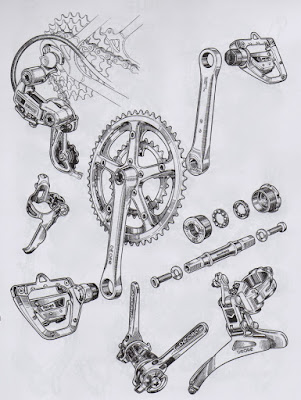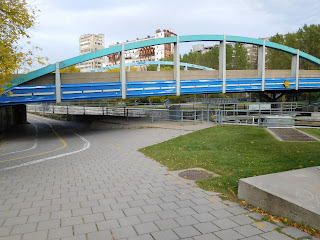I haven't started to work on my estate-sale find yet. I have, however begun to rummage through some components I have on hand and order a buy a few things (small parts) I need.
I did, however, begin to do a little research. According to the serial number on the frame, and the information I found on the Vintage Trek website, my bike is probably a 1982 model. The serial number pattern fits in with 400 series bikes made from 1980 to 1982, but the presence of a color band on the seat tube points to 1982. On the other hand, the 412 pictured in the 1982 brochure has brazed-on brake cable guides and water bottle bosses, which my bike does not have. Perhaps it's a 1981.5 model: According to the VT website, the highest-priced Treks (Pro and 900 series), started to come with such bands in 1981. (The white bikes with blue panels are particularly nice, to my eye.) That feature "trickled down" to the 700 series bikes in the middle of that year (1981.5). The 1982 brochures show 500 and 400 series models with it but, according to the website, some of those models came with color bands in late 1981.
(Mercians, at least those made after 1970, are easier to track: I had no trouble finding out Vera was made in 1994, as her original owner told me. And, of course, I know that Arielle, Tosca and Helene are from 2006, 2007 and 2010, resepctively, because I had them custom-made in those years.
OK, so now I know the bike's origins, more or less. Now I'm starting to learn a bit about the bike's quirks, aside from the ones I've already mentioned. Actually, it's not a terribly quirky bike, from what I can see: Threadings and other dimensions are standard, and in design it's much like other bikes of its type made around the same time, though perhaps somewhat better.
One quirk I found is in the componentry: specifically, the Sakae crankset. I know that some cranksets of that time were made with the 110 BCD chainring pattern, which is common today--and of which I have a few chainrings on hand. I was hoping that the SR crankset--which looks rather nice--shared it.
Alas! If you ever wonder what difference a few millimeters can make, you can see it here. The black ring that I superimposed on the crank is a 110 made by Stronglight; the rings on the crankset have a slightly bigger bolt circle. From the measurements I made, and Sheldon Brown's "crib sheet", it seems that the crank has the now-obsolete 118 BCD. That means, of course, that I could find replacement chainrings only through swap meets and, with luck, on eBay.
(My surprise is, I'm sure, mild compared to the frustration an owner of a Nervar Star crankset might feel: Its 128 BCD, as close as it is to the 130 BCD of modern road racing cranks, still precludes interchangeability!)
The rings on the bike don't seem to have much wear, so I think I'll keep them on for now: They, and the crankset, look pretty nice. (From what I can see, the arms are forged.) The 52 tooth outer ring, standard for the era when the bike was made, is bigger than anything I ride now. On the other hand, I am using 12 tooth rear cogs with my 46 and 48 tooth chainrings (and a 17 with the 47 tooth ring on Tosca, my Mercian fixed gear): something that didn't exist at the time the bike was made. Then, most cyclists rode with freewheels on which the smallest cog had 14 teeth, which is what orignally came with the bike; racers sometimes used 13 tooth cogs. If I use a freewheel with a 14 tooth cog, my highest gear will still be slightly lower than those of Arielle, Helene and Vera, my geared Mercians. (Arielle, the road bike, has 48X12, while Helene and Vera have 46X12.)
One thing I have to say about the crank: The bottom bracket--which, I believe, is the original--turns very smoothly. I think someone recently overhauled it; still, I might take it apart if, for no other reason, to be sure that it has an intact protector sleeve.
Speaking of smooth bearings: The headset feels good, but I might clean it anyway, just because I don't know when I'll do it again. And I have a rear hub that I'm thinking of using. The Phil that came with the bike is great, but it's 48 hole, and the rim it's laced to is 27 inches--which I'm not going to use, since I don't have a 27 inch front (The one that came with the bike wasn't salvageable.) rim, wheel or tire, and don't want to buy new ones. The hub I have is pretty nice, though not quite as good as the Phil.
This is going to be an interesting project. I'll probably start working on it in a couple of weeks, after classes have ended.
I did, however, begin to do a little research. According to the serial number on the frame, and the information I found on the Vintage Trek website, my bike is probably a 1982 model. The serial number pattern fits in with 400 series bikes made from 1980 to 1982, but the presence of a color band on the seat tube points to 1982. On the other hand, the 412 pictured in the 1982 brochure has brazed-on brake cable guides and water bottle bosses, which my bike does not have. Perhaps it's a 1981.5 model: According to the VT website, the highest-priced Treks (Pro and 900 series), started to come with such bands in 1981. (The white bikes with blue panels are particularly nice, to my eye.) That feature "trickled down" to the 700 series bikes in the middle of that year (1981.5). The 1982 brochures show 500 and 400 series models with it but, according to the website, some of those models came with color bands in late 1981.
(Mercians, at least those made after 1970, are easier to track: I had no trouble finding out Vera was made in 1994, as her original owner told me. And, of course, I know that Arielle, Tosca and Helene are from 2006, 2007 and 2010, resepctively, because I had them custom-made in those years.
OK, so now I know the bike's origins, more or less. Now I'm starting to learn a bit about the bike's quirks, aside from the ones I've already mentioned. Actually, it's not a terribly quirky bike, from what I can see: Threadings and other dimensions are standard, and in design it's much like other bikes of its type made around the same time, though perhaps somewhat better.
One quirk I found is in the componentry: specifically, the Sakae crankset. I know that some cranksets of that time were made with the 110 BCD chainring pattern, which is common today--and of which I have a few chainrings on hand. I was hoping that the SR crankset--which looks rather nice--shared it.
Alas! If you ever wonder what difference a few millimeters can make, you can see it here. The black ring that I superimposed on the crank is a 110 made by Stronglight; the rings on the crankset have a slightly bigger bolt circle. From the measurements I made, and Sheldon Brown's "crib sheet", it seems that the crank has the now-obsolete 118 BCD. That means, of course, that I could find replacement chainrings only through swap meets and, with luck, on eBay.
(My surprise is, I'm sure, mild compared to the frustration an owner of a Nervar Star crankset might feel: Its 128 BCD, as close as it is to the 130 BCD of modern road racing cranks, still precludes interchangeability!)
The rings on the bike don't seem to have much wear, so I think I'll keep them on for now: They, and the crankset, look pretty nice. (From what I can see, the arms are forged.) The 52 tooth outer ring, standard for the era when the bike was made, is bigger than anything I ride now. On the other hand, I am using 12 tooth rear cogs with my 46 and 48 tooth chainrings (and a 17 with the 47 tooth ring on Tosca, my Mercian fixed gear): something that didn't exist at the time the bike was made. Then, most cyclists rode with freewheels on which the smallest cog had 14 teeth, which is what orignally came with the bike; racers sometimes used 13 tooth cogs. If I use a freewheel with a 14 tooth cog, my highest gear will still be slightly lower than those of Arielle, Helene and Vera, my geared Mercians. (Arielle, the road bike, has 48X12, while Helene and Vera have 46X12.)
One thing I have to say about the crank: The bottom bracket--which, I believe, is the original--turns very smoothly. I think someone recently overhauled it; still, I might take it apart if, for no other reason, to be sure that it has an intact protector sleeve.
Speaking of smooth bearings: The headset feels good, but I might clean it anyway, just because I don't know when I'll do it again. And I have a rear hub that I'm thinking of using. The Phil that came with the bike is great, but it's 48 hole, and the rim it's laced to is 27 inches--which I'm not going to use, since I don't have a 27 inch front (The one that came with the bike wasn't salvageable.) rim, wheel or tire, and don't want to buy new ones. The hub I have is pretty nice, though not quite as good as the Phil.
This is going to be an interesting project. I'll probably start working on it in a couple of weeks, after classes have ended.




























































